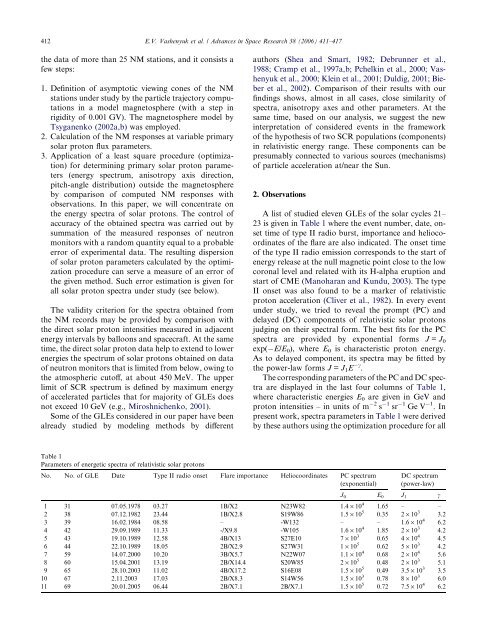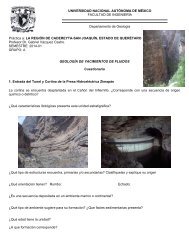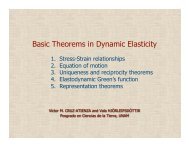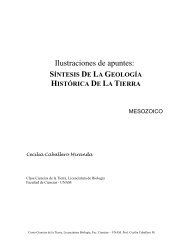Some features of the sources of relativistic particles at the Sun in the ...
Some features of the sources of relativistic particles at the Sun in the ...
Some features of the sources of relativistic particles at the Sun in the ...
- No tags were found...
You also want an ePaper? Increase the reach of your titles
YUMPU automatically turns print PDFs into web optimized ePapers that Google loves.
412 E.V. Vashenyuk et al. / Advances <strong>in</strong> Space Research 38 (2006) 411–417<strong>the</strong> d<strong>at</strong>a <strong>of</strong> more than 25 NM st<strong>at</strong>ions, and it consists afew steps:1. Def<strong>in</strong>ition <strong>of</strong> asymptotic view<strong>in</strong>g cones <strong>of</strong> <strong>the</strong> NMst<strong>at</strong>ions under study by <strong>the</strong> particle trajectory comput<strong>at</strong>ions<strong>in</strong> a model magnetosphere (with a step <strong>in</strong>rigidity <strong>of</strong> 0.001 GV). The magnetosphere model byTsyganenko (2002a,b) was employed.2. Calcul<strong>at</strong>ion <strong>of</strong> <strong>the</strong> NM responses <strong>at</strong> variable primarysolar proton flux parameters.3. Applic<strong>at</strong>ion <strong>of</strong> a least square procedure (optimiz<strong>at</strong>ion)for determ<strong>in</strong><strong>in</strong>g primary solar proton parameters(energy spectrum, anisotropy axis direction,pitch-angle distribution) outside <strong>the</strong> magnetosphereby comparison <strong>of</strong> computed NM responses withobserv<strong>at</strong>ions. In this paper, we will concentr<strong>at</strong>e on<strong>the</strong> energy spectra <strong>of</strong> solar protons. The control <strong>of</strong>accuracy <strong>of</strong> <strong>the</strong> obta<strong>in</strong>ed spectra was carried out bysumm<strong>at</strong>ion <strong>of</strong> <strong>the</strong> measured responses <strong>of</strong> neutronmonitors with a random quantity equal to a probableerror <strong>of</strong> experimental d<strong>at</strong>a. The result<strong>in</strong>g dispersion<strong>of</strong> solar proton parameters calcul<strong>at</strong>ed by <strong>the</strong> optimiz<strong>at</strong>ionprocedure can serve a measure <strong>of</strong> an error <strong>of</strong><strong>the</strong> given method. Such error estim<strong>at</strong>ion is given forall solar proton spectra under study (see below).The validity criterion for <strong>the</strong> spectra obta<strong>in</strong>ed from<strong>the</strong> NM records may be provided by comparison with<strong>the</strong> direct solar proton <strong>in</strong>tensities measured <strong>in</strong> adjacentenergy <strong>in</strong>tervals by balloons and spacecraft. At <strong>the</strong> sametime, <strong>the</strong> direct solar proton d<strong>at</strong>a help to extend to lowerenergies <strong>the</strong> spectrum <strong>of</strong> solar protons obta<strong>in</strong>ed on d<strong>at</strong>a<strong>of</strong> neutron monitors th<strong>at</strong> is limited from below, ow<strong>in</strong>g to<strong>the</strong> <strong>at</strong>mospheric cut<strong>of</strong>f, <strong>at</strong> about 450 MeV. The upperlimit <strong>of</strong> SCR spectrum is def<strong>in</strong>ed by maximum energy<strong>of</strong> acceler<strong>at</strong>ed <strong>particles</strong> th<strong>at</strong> for majority <strong>of</strong> GLEs doesnot exceed 10 GeV (e.g., Miroshnichenko, 2001).<strong>Some</strong> <strong>of</strong> <strong>the</strong> GLEs considered <strong>in</strong> our paper have beenalready studied by model<strong>in</strong>g methods by differentauthors (Shea and Smart, 1982; Debrunner et al.,1988; Cramp et al., 1997a,b; Pchelk<strong>in</strong> et al., 2000; Vashenyuket al., 2000; Kle<strong>in</strong> et al., 2001; Duldig, 2001; Bieberet al., 2002). Comparison <strong>of</strong> <strong>the</strong>ir results with ourf<strong>in</strong>d<strong>in</strong>gs shows, almost <strong>in</strong> all cases, close similarity <strong>of</strong>spectra, anisotropy axes and o<strong>the</strong>r parameters. At <strong>the</strong>same time, based on our analysis, we suggest <strong>the</strong> new<strong>in</strong>terpret<strong>at</strong>ion <strong>of</strong> considered events <strong>in</strong> <strong>the</strong> framework<strong>of</strong> <strong>the</strong> hypo<strong>the</strong>sis <strong>of</strong> two SCR popul<strong>at</strong>ions (components)<strong>in</strong> <strong>rel<strong>at</strong>ivistic</strong> energy range. These components can bepresumably connected to various <strong>sources</strong> (mechanisms)<strong>of</strong> particle acceler<strong>at</strong>ion <strong>at</strong>/near <strong>the</strong> <strong>Sun</strong>.2. Observ<strong>at</strong>ionsA list <strong>of</strong> studied eleven GLEs <strong>of</strong> <strong>the</strong> solar cycles 21–23 is given <strong>in</strong> Table 1 where <strong>the</strong> event number, d<strong>at</strong>e, onsettime <strong>of</strong> type II radio burst, importance and heliocoord<strong>in</strong><strong>at</strong>es<strong>of</strong> <strong>the</strong> flare are also <strong>in</strong>dic<strong>at</strong>ed. The onset time<strong>of</strong> <strong>the</strong> type II radio emission corresponds to <strong>the</strong> start <strong>of</strong>energy release <strong>at</strong> <strong>the</strong> null magnetic po<strong>in</strong>t close to <strong>the</strong> lowcoronal level and rel<strong>at</strong>ed with its H-alpha eruption andstart <strong>of</strong> CME (Manoharan and Kundu, 2003). The typeII onset was also found to be a marker <strong>of</strong> <strong>rel<strong>at</strong>ivistic</strong>proton acceler<strong>at</strong>ion (Cliver et al., 1982). In every eventunder study, we tried to reveal <strong>the</strong> prompt (PC) anddelayed (DC) components <strong>of</strong> <strong>rel<strong>at</strong>ivistic</strong> solar protonsjudg<strong>in</strong>g on <strong>the</strong>ir spectral form. The best fits for <strong>the</strong> PCspectra are provided by exponential forms J = J 0exp( E/E 0 ), where E 0 is characteristic proton energy.As to delayed component, its spectra may be fitted by<strong>the</strong> power-law forms J = J 1 E c .The correspond<strong>in</strong>g parameters <strong>of</strong> <strong>the</strong> PC and DC spectraare displayed <strong>in</strong> <strong>the</strong> last four columns <strong>of</strong> Table 1,where characteristic energies E 0 are given <strong>in</strong> GeV andproton <strong>in</strong>tensities – <strong>in</strong> units <strong>of</strong> m 2 s 1 sr 1 Ge V 1 .Inpresent work, spectra parameters <strong>in</strong> Table 1 were derivedby <strong>the</strong>se authors us<strong>in</strong>g <strong>the</strong> optimiz<strong>at</strong>ion procedure for allTable 1Parameters <strong>of</strong> energetic spectra <strong>of</strong> <strong>rel<strong>at</strong>ivistic</strong> solar protonsNo. No. <strong>of</strong> GLE D<strong>at</strong>e Type II radio onset Flare importance Heliocoord<strong>in</strong><strong>at</strong>es PC spectrum(exponential)DC spectrum(power-law)J 0 E 0 J 1 c1 31 07.05.1978 03.27 1B/X2 N23W82 1.4 · 10 4 1.65 – –2 38 07.12.1982 23.44 1B/X2.8 S19W86 1.5 · 10 5 0.35 2 · 10 3 3.23 39 16.02.1984 08.58 – -W132 – – 1.6 · 10 4 6.24 42 29.09.1989 11.33 -/X9.8 -W105 1.6 · 10 4 1.85 2 · 10 3 4.25 43 19.10.1989 12.58 4B/X13 S27E10 7 · 10 3 0.65 4 · 10 4 4.56 44 22.10.1989 18.05 2B/X2.9 S27W31 1 · 10 5 0.62 5 · 10 3 4.27 59 14.07.2000 10.20 3B/X5.7 N22W07 1.1 · 10 4 0.68 2 · 10 4 5.68 60 15.04.2001 13.19 2B/X14.4 S20W85 2 · 10 5 0.48 2 · 10 3 5.19 65 28.10.2003 11.02 4B/X17.2 S16E08 1.5 · 10 5 0.49 3.5 · 10 3 3.510 67 2.11.2003 17.03 2B/X8.3 S14W56 1.5 · 10 3 0.78 8 · 10 3 6.011 69 20.01.2005 06.44 2B/X7.1 2B/X7.1 1.5 · 10 5 0.72 7.5 · 10 4 6.2
















